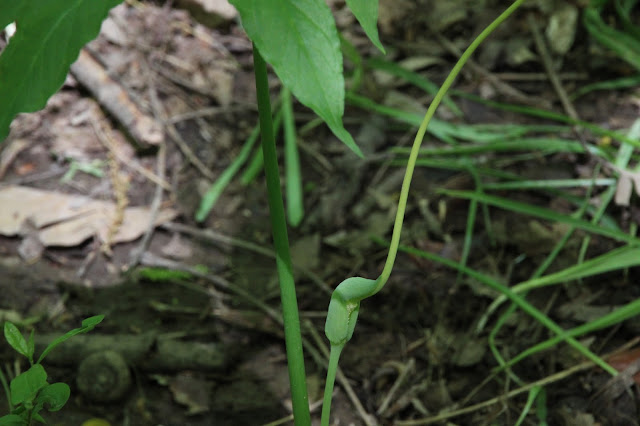We are fortunate in Ohio to have over 40 different species of wild
orchids, which range from eye-poppingly gorgeous to nearly inconspicuous.
Orchid seeds are extremely small and almost dust-like. They contain no food for the developing plant (think about all the food contained in a bean or sunflower seed; orchids have none of that) and fungi are necessary to supply nutrients for germination and growth. The symbiotic relationships between the roots of orchids and a variety of fungi are called mycorrhizae. All orchids depend on fungi to supply some of their nutrients at some point in their life cycle. Many adult orchids retain the symbiotic relationship with fungi, although the benefits to the adult photosynthetic orchid and the fungus remain largely unexplored. Some orchids are non-photosynthetic and they are likely entirely dependent on the fungus for energy. Apparently, when the orchids are older, they pass nutrients to the fungi, making it a mutually beneficial relationship. Because of these important relationships with certain fungi, attempts to transplant these orchids are usually futile.
Orchid seeds are extremely small and almost dust-like. They contain no food for the developing plant (think about all the food contained in a bean or sunflower seed; orchids have none of that) and fungi are necessary to supply nutrients for germination and growth. The symbiotic relationships between the roots of orchids and a variety of fungi are called mycorrhizae. All orchids depend on fungi to supply some of their nutrients at some point in their life cycle. Many adult orchids retain the symbiotic relationship with fungi, although the benefits to the adult photosynthetic orchid and the fungus remain largely unexplored. Some orchids are non-photosynthetic and they are likely entirely dependent on the fungus for energy. Apparently, when the orchids are older, they pass nutrients to the fungi, making it a mutually beneficial relationship. Because of these important relationships with certain fungi, attempts to transplant these orchids are usually futile.
Anyway, I am fascinated by these plants and we are making an effort to see and photograph as many Ohio wild orchids this year as we can. Many orchids require habitats that are rare or are
threatened by development so finding them is a special occasion worthy of
celebration and lots of photos! Here is just a small sampling of Ohio's beautiful orchids; more will follow.
One of the first orchids to bloom in the spring is one of my favorites, the showy orchis (Galearis spectabilis). What a stunner!
Found in rich deciduous woodlands, this plant has a wide range throughout the eastern and midwestern U.S. This particular plant and the next three species were found in Shawnee State Forest in southern Ohio. This orchid-rich area drew us to register for Flora-Quest, a wonderful event at the end of April that featured excellent botanical field trips, lots of butterflies and even moths! I could blog for weeks about what we saw!
Many hikers are quite familiar with the pink lady’s slipper (Cypripedium acaule). This plant grows in a variety of woodland habitats and blooms in early spring. It is very slow growing and, like most orchids, transplanting it is rarely successful. The structure of orchid flowers is quite variable, but all are designed to attract pollinators. In the case of the pink lady's slipper, the flower is pollinated by bees, which enter the pouch and can only exit by brushing against structures that remove pollen from a previous flower. Then the bee picks up new pollen on its way out.
Many hikers are quite familiar with the pink lady’s slipper (Cypripedium acaule). This plant grows in a variety of woodland habitats and blooms in early spring. It is very slow growing and, like most orchids, transplanting it is rarely successful. The structure of orchid flowers is quite variable, but all are designed to attract pollinators. In the case of the pink lady's slipper, the flower is pollinated by bees, which enter the pouch and can only exit by brushing against structures that remove pollen from a previous flower. Then the bee picks up new pollen on its way out.
Here is a side view:
The next gorgeous orchid that we spotted at FloraQuest was the incomparable yellow lady's slipper (Cypripedium parvifolium). It often occurs in clumps and can be quite showy. The twisted sepals definitely add to its exotic appearance.
Here is a rare beauty that I thought I would never see. The leaders at Flora-Quest knew where to look, though, and we were fortunate to see this incomparable specimen:
This orchid is called a large whorled pogonia (Isotria verticillata). It occurs throughout the eastern U.S. but is never particularly common. It requires acid soils, and prefers streambanks and woodlands. Here is the front view:
Isn't that amazing? It really makes me think hard about how and why a flower has evolved into this unusual configuration. I sure don't have all the answers, but I know it has to do with attracting suitable pollinators!
I hope that these four orchids whet your appetite for more. I'll soon have another post covering some of the other Ohio orchids, both showy and inconspicuous!













